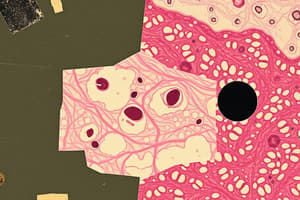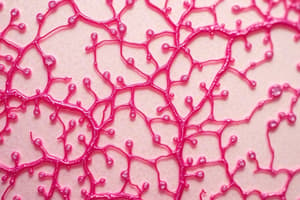Podcast
Questions and Answers
Which type of epithelial tissue is characterized by its single layer of cells?
Which type of epithelial tissue is characterized by its single layer of cells?
- Simple (correct)
- Columnar
- Cuboidal
- Stratified
Which epithelial tissue type is responsible for lining the walls of blood vessels?
Which epithelial tissue type is responsible for lining the walls of blood vessels?
- Simple squamous (correct)
- Stratified squamous
- Simple columnar
- Pseudostratified columnar
Which type of epithelial tissue is found in the lining of the digestive tract?
Which type of epithelial tissue is found in the lining of the digestive tract?
- Simple squamous
- Simple columnar (correct)
- Simple cuboidal
- Stratified squamous
Which type of tissue is primarily involved in secretion, absorption, and protective functions?
Which type of tissue is primarily involved in secretion, absorption, and protective functions?
Which of the following is NOT a characteristic of stratified epithelial tissue?
Which of the following is NOT a characteristic of stratified epithelial tissue?
Which type of epithelial tissue is responsible for lining the urinary bladder?
Which type of epithelial tissue is responsible for lining the urinary bladder?
Which of the following is a primary function of stratified squamous epithelium?
Which of the following is a primary function of stratified squamous epithelium?
Which type of epithelial tissue is found in the lining of the respiratory tract?
Which type of epithelial tissue is found in the lining of the respiratory tract?
Which of the following tissues has a watery intercellular matrix?
Which of the following tissues has a watery intercellular matrix?
What is the primary function of neuroglia?
What is the primary function of neuroglia?
Which type of muscle tissue is found in the heart?
Which type of muscle tissue is found in the heart?
What is the process of replacing injured tissue with scar tissue called?
What is the process of replacing injured tissue with scar tissue called?
Which of the following is NOT an example of a serous membrane?
Which of the following is NOT an example of a serous membrane?
What is the primary function of the reticular connective tissue?
What is the primary function of the reticular connective tissue?
Which tissue type is responsible for lining cavities that open to the outside?
Which tissue type is responsible for lining cavities that open to the outside?
Which type of connective tissue is responsible for attaching muscles to bones?
Which type of connective tissue is responsible for attaching muscles to bones?
Which of the following is a characteristic of epithelial membranes?
Which of the following is a characteristic of epithelial membranes?
What distinguishes cartilage from bone?
What distinguishes cartilage from bone?
Which of the following is a type of connective tissue membrane?
Which of the following is a type of connective tissue membrane?
Which of the following types of connective tissue is NOT found in the human body?
Which of the following types of connective tissue is NOT found in the human body?
Which connective tissue type is characterized by a gel-like intercellular matrix and a loose arrangement of fibers?
Which connective tissue type is characterized by a gel-like intercellular matrix and a loose arrangement of fibers?
What is the main component of tendons and ligaments?
What is the main component of tendons and ligaments?
Which type of cartilage is found in the external ear and parts of the larynx?
Which type of cartilage is found in the external ear and parts of the larynx?
Which of these statements about collagen is NOT true?
Which of these statements about collagen is NOT true?
Which of the following is NOT a function of epithelial tissue?
Which of the following is NOT a function of epithelial tissue?
How does epithelial tissue in the respiratory tract help clean inhaled air?
How does epithelial tissue in the respiratory tract help clean inhaled air?
What is the primary characteristic that distinguishes different types of connective tissue?
What is the primary characteristic that distinguishes different types of connective tissue?
Which of the following is an example of an exocrine gland?
Which of the following is an example of an exocrine gland?
Why do injuries to tendons and ligaments heal slowly?
Why do injuries to tendons and ligaments heal slowly?
Which of the following is NOT a characteristic of epithelial tissue?
Which of the following is NOT a characteristic of epithelial tissue?
What is the main function of the epithelial tissue lining the digestive tract?
What is the main function of the epithelial tissue lining the digestive tract?
Which of the following is a characteristic of both connective tissue and epithelial tissue?
Which of the following is a characteristic of both connective tissue and epithelial tissue?
Flashcards
Skeletal System
Skeletal System
System formed by hard intercellular matrix providing protection and enabling movement.
Blood and Lymph
Blood and Lymph
Fluid connective tissues with a watery intercellular matrix involved in transport.
Neurons
Neurons
Cell type in nervous tissue responsible for conducting electrical signals.
Neuroglia
Neuroglia
Signup and view all the flashcards
Skeletal Muscle
Skeletal Muscle
Signup and view all the flashcards
Smooth Muscle
Smooth Muscle
Signup and view all the flashcards
Regeneration
Regeneration
Signup and view all the flashcards
Fibrosis
Fibrosis
Signup and view all the flashcards
Intercellular matrix
Intercellular matrix
Signup and view all the flashcards
Types of connective tissue
Types of connective tissue
Signup and view all the flashcards
Loose connective tissue
Loose connective tissue
Signup and view all the flashcards
Adipose tissue
Adipose tissue
Signup and view all the flashcards
Dense fibrous connective tissue
Dense fibrous connective tissue
Signup and view all the flashcards
Cartilage
Cartilage
Signup and view all the flashcards
Types of cartilage
Types of cartilage
Signup and view all the flashcards
Bone (Osseous tissue)
Bone (Osseous tissue)
Signup and view all the flashcards
Tissue
Tissue
Signup and view all the flashcards
Membrane
Membrane
Signup and view all the flashcards
Histology
Histology
Signup and view all the flashcards
Epithelial Tissue
Epithelial Tissue
Signup and view all the flashcards
Simple Epithelium
Simple Epithelium
Signup and view all the flashcards
Stratified Epithelium
Stratified Epithelium
Signup and view all the flashcards
Squamous Cells
Squamous Cells
Signup and view all the flashcards
Transitional Epithelium
Transitional Epithelium
Signup and view all the flashcards
Cilia
Cilia
Signup and view all the flashcards
Mucus Secretion
Mucus Secretion
Signup and view all the flashcards
Avascular
Avascular
Signup and view all the flashcards
Exocrine Glands
Exocrine Glands
Signup and view all the flashcards
Endocrine Glands
Endocrine Glands
Signup and view all the flashcards
Connective Tissue
Connective Tissue
Signup and view all the flashcards
Study Notes
Tissues and Membranes
- Tissues are groups of similar cells working together, with shared structure and function.
- Membranes are thin sheets of tissue covering surfaces, lining body cavities, and surrounding organs.
- Four major tissue types: epithelial, connective, nervous, and muscular.
- Histology is the study of tissues.
- Epithelial tissue covers surfaces, lines cavities, and performs secretion, absorption, and protection.
- Classified by cell shape (squamous, cuboidal, columnar) and layers (simple, stratified).
- Simple squamous: thin, flat cells (e.g., walls of blood vessels).
- Simple cuboidal: cube-shaped cells (e.g., kidney tubules).
- Simple columnar: tall, narrow cells (e.g., digestive tract).
- Pseudostratified columnar: appears layered but is single-layered (e.g., respiratory tract). Stratified squamous: multiple layers of cells (e.g., skin).
- Stratified cuboidal: multiple layers of cuboidal cells (rare).
- Stratified columnar: multiple layers of columnar cells (rare).
- Transitional: specialized cells that change shape (e.g., urinary bladder).
- Connective tissue is the most abundant tissue type, providing support, connection, protection, and storage.
- Found in blood, under skin, bone, around many organs.
- Connects, protects, stores fat, and transports.
- Composed of cells embedded in an extracellular matrix (liquid, gel-like, or solid).
- Contains fibers like collagen (strong), elastin (stretchy), and reticular (fine collagen).
- Types: loose connective (areolar, adipose, reticular), dense fibrous connective (tendons, ligaments, fascia), cartilage (hyaline, elastic, fibrocartilage), and bone (osseus tissue).
- Nervous tissue transmits electrical signals.
- Contains neurons (transmit signals) and neuroglia (support neurons).
- Muscle tissue contracts to cause movement.
- Types: skeletal (attached to bones), smooth (walls of internal organs), and cardiac (heart).
- Membranes include epithelial membranes (cutaneous, mucous, serous) and connective tissue membranes (synovial, periosteum, perichondrium, meninges, fascia)
- Protection, absorption, filtration, and secretion are among the crucial functions of epithelial membranes.
- Specialized functions of particular tissues, such as protection, secretion, support, and others are crucial.
Tissue Functions
- Protection: Skin and some types of epithelial tissue shield the body from the elements and pathogens.
- Absorption: Epithelial tissue in the digestive tract absorbs nutrients.
- Filtration: Epithelial tissue filters substances in structures like the kidneys.
- Secretion: Epithelial glands secrete hormones and other substances.
- Support: Connective tissue supports the body and connects its parts.
- Movement: Muscle tissue enables body movements; skeletal muscle controls movements.
- Conduction: Nervous tissue transmits information throughout the body.
Studying That Suits You
Use AI to generate personalized quizzes and flashcards to suit your learning preferences.




